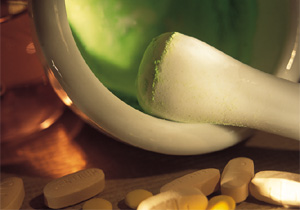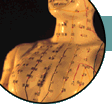Differentiating Syndromes according to the Theory of Wei, Qi, Ying, and Xue
This is a method of analyzing and judging the development of
febrile diseases caused by exogenous pathogenic factors. Wei (outer
defensive), qi (inner defensive), ying (nutrient), and xue (blood) are
not only generalizations of the four types of febrile disease syndromes,
but also a reflection of the four grades of severity of febrile diseases
during their development.
1. Wei (Outer Defensive) Stage Syndrome
Wei (outer defensive) stage syndromes are seen at the onset of epidemic
febrile diseases, the pathological changes occurring in the lung, and
on the skin and hair. Clinical manifestations are characterized by the
common exterior syndromes of fever and aversion to wind and cold.
Main clinical manifestations: Fever, a slight aversion to wind and cold, very little or no sweating, cough, headache, sore throat, slight thirst, a red tongue tip with thin white or slight yellowish tongue coating, floating and rapid pulse.
An attack of mild pathogenic heat on the body surface blocks the circulation of wei (defensive) qi, thus leading to dysfunction of the opening and closing of the pores and weakness of the defensive function of the body surface. Symptoms of fever, slight aversion to wind and cold, little or no sweating, and headache result. The lung dominates the skin and hair. Since the wei qi is blocked on the body surface, then the lung qi loses its function of spreading and descending qi, thus cough and sore throat result. Thirst is caused by pathogenic heat consuming the body fluid. Red tongue tip with white thin or yellowish tongue coating, floating and rapid pulse are all signs indicating pathogenic mild heat attacking the wei qi of the body.
These symptoms are mainly manifestations of the loss of wei qi's defensive function and also indicate a failure of the spread and descent of qi. If pathogenic factors mainly affect the skin and hair, that is, the body surface, then they are characterized by fever, thirst, and sore throat. If the lung is mainly affected, the chief complaint will be cough and sore throat.
2. Qi (Inner Defensive) Stage Syndrome
Syndromes of the qi (inner defensive) stage are the syndromes of
interior heat due to the inner defense being invaded by pathogenic heat.
In this case the anti-pathogenic qi and the pathogenic factor are very
strong, resulting in hyperactivity of yang heat. Clinical manifestations
are fever and no fear of cold.
Since the affected location alters after pathogenic heat is transmitted into the interior, the syndromes of the qi stage can then be classified into different types as follows:
Mild heat in the lung
Fever, perspiration, thirst, cough, asthma, chest pain, red tongue proper with yellow coating, rapid pulse.
Preponderance of interior heat causes fever, rapid pulse, and red tongue proper with yellow coating. Interior heat steams the body fluid bringing on perspiration and thirst. Retention of pathogenic heat in the lung leads to the dysfunction of lung qi's spread and descent, so cough, asthma, and chest pain occur.
Accumulation of pathogenic heat in the chest and diaphragm
Fever, irritability, depression, restlessness, red tongue proper, slight yellowish tongue coating, thirst, constipation, rapid pulse.
Retention of heat inside the body causes fever. Pathogenic heat disturbs the mind, so irritability and restlessness result. Pathogenic heat consumes the body fluid resulting in thirst and constipation. Red tongue proper with a slightly yellowish coating , and rapid pulse are signs of excessive pathogenic heat.
Heat transmitted into the stomach
High fever, thirst with preference for cold drinks, profuse sweating, anxiety, dry and yellowish tongue coating, full and forceful pulse.
The pathogenesis and differentiation of qi stage syndromes is the same as for the Yangming channel syndromes. The only difference is the slower development of the disease condition after the invasion of pathogenic cold is transmitted from the Taiyang into the Yangming, while the transmission of pathogenic mild heat into heat is faster after it enters into the interior.
Retention of pathogenic heat in the liver and gall bladder
Retching, bitter taste in the mouth with thirst, irritability, insomnia, hypochondriac pain, yellowish tongue coating, wiry and rapid pulse.
Disharmony of qi circulation in the liver and gall bladder channels is due to interior heat retention in the liver and gall bladder. This causes hypochondriac pain, bitter taste in the mouth and a wiry pulse. Stagnation of heat in the liver and gall bladder affects the stomach, causing retching. Pathogenic heat disturbing the heart and mind brings on irritability and insomnia. A yellowish tongue coating and thirst are signs of excessive pathogenic heat.
Retention of pathogenic mild heat in the intestine
There are two different groups of clinical manifestations as follows:
(1) Dryness of the intestine causing constipation with manifestations being the same a syndromes of the Yangmin fu organs.
(2) Heat in the intestine leading to diarrhea, a burning sensation around the anus, thirst, yellowish and dry tongue coating, rapid pulse.
Descending heat in the intestine causes a dysfunction of transportation and transformation, thus diarrhea and a burning sensation around the anus result. Pathogenic heat consuming the body fluid produces thirst. Yellowish tongue coating and rapid pulse are signs of excessive pathogenic heat.
3. Yin (Nutrient) Stage Syndromes
The syndromes of the yin (nutrient) stage occur when pathogenic mild
heat is transmitted into the superficial layer of the blood. Ying is
a component of the blood, so the disease location is actually in the
heart and pericardium. Pathological characteristics show the injury of
nutrient yin and the disturbance of heart-mind.
Pathogenic heat injuring nutrient yin
Fever (worse at night), irritability, insomnia, or even coma and delirium, recessive rashes, slight thirst, deep red tongue proper, thready and rapid pulse.
Pathogenic mild heat invades deeply into the ying stage, thus scorching and injuring the nutrient yin and leading to insufficiency of blood, so the fever worsens at night and a rapid thready pulse results. pathogenic heat steams nutrient yin causing a slight thirst. Heat disturbs the mind leading to irritability, insomnia, or even coma and delirium. Pathogenic heat causes a disorderly flow of blood, thus a recessive, deep red tongue proper manifests.
Heat attacking the pericardium
Fever, coma, delirium, deep red tongue proper, rapid pulse. After pathogenic heat attacks the pericardium, it disturbs the heart-mind bringing on fever, coma, and delirium. A deep red tongue proper is a sign of heat in the blood. Rapid pulse indicates excessive heat.
4. Xue Stage Syndromes
Syndromes of the xue (blood) stage denote pathogenic mild heat
invading the blood to the deepest stage. The pathological changes
are mainly in the liver and kidney. Clinical manifestations are
characterized by heat in the blood causing disorderly flow, stirring
up of wind and heat, and injury of body yin.
Heat in the blood causing disorderly flow
Hemorrhage (including hematemesis, epistaxis, bloody stools, purpura, and vaginal bleeding), blood of a dark red or dark purple color, fever (worse at night), irritability, insomnia, feverish sensation of the palms and soles, deep red tongue proper, and rapid pulse.
Extreme heat in the blood stage forces a disorderly flow of the blood causing hemorrhage. Blood of a dark red or dark purple color indicates heat. Fever, worse at night, and a feverish sensation of the palms and soles are both signs of heat in the blood causing yin deficiency. Irritability and insomnia result from heat disturbing the heart-mind. A deep red tongue proper and a rapid pulse are the manifestations of extreme heat in the blood.
Heat in the liver stirring up wind
Headache, dizziness, redness of the eyes, irritability, fever, thirst, stiffness of the neck and back, contracture of the four extremities, deep red tongue proper, wiry and rapid pulse.
Headache, redness of the eyes, dizziness are caused by heat in the liver channel. Irritability and thirst result from pathogenic mild heat consuming the body fluid. Extreme heat exhausts the yin fluid of the body, thus the blood fails to nourish the tendons with resulting stiffness of the neck and back, and contracture of the four limbs. A deep red tongue proper, and a wiry rapid pulse are signs of heat in the blood of the liver channel.
Heat in the blood injures yin
Fever, flushed face, heat of the palms and soles, dryness of the mouth, listlessness, deafness, xu and forceless pulse, accompanied by irritability, insomnia, protracted fever at dusk, chilliness in the early morning, no sweating after the fever subsides, red tongue proper with scanty coating, thready and rapid pulse.
Hot palms and soles, flushed face, dryness of the mouth, and deafness are all signs of yin deficiency and yang floating upward. Listlessness and xu pulse are caused by the insufficiency of essence and blood. Irritability and insomnia are due to yin deficiency producing a preponderance of fire which disturbs the hear-mind. No sweating after fever subsides, fever at dusk, and chilliness in the early morning are characteristics of yin deficiency producing heat.
Perishing of yin and excessive loss of fluid
Slim limbs, withered lips and shrunk tongue, dryness of gums, depressed eyes, unconsciousness, flushed cheeks, coldness of extremities, squirming fingers, feeble and unfelt pulse, or even convulsion.
Atrophy and dryness of the limbs, lips and tongue, dryness of the gums, and depressed eyes are manifestations of perishing yin and excessive loss of fluid. Unconsciousness, feeble and unfelt pulse are signs showing complete exhaustion of yin fluid. Flushed cheeks, and cold extremities are signs of a heat nature showing the internal draining of yin fluid leading to the upward floating of ying qi, and a failure of yang qi to warm and nourish the four extremities. Squirming fingers indicate malnourishment of the tendons due to the internal draining of yin fluid, thus causing an internal stirring of xu wind.
|

 This website is published, edited and designed by Raymond Cheng,
and reflects only and only his personal views and opinions in his individual capacity.
The information available at this website is not intended
directly or by implication to either diagnose or treat any
medical, emotional, or psychological condition or disorder.
It is also not intended to create a physician-patient relationship
between you and I or between you and Wyith Institute™ and The Office of Dr Raymond K K Cheng.
The information here is not a substitute for advice and treatment provided
by your physician or by another healthcare professional.
It is always recommended that consultation with local healthcare providers
be obtained for any of your specific health or medical concerns.
Furthermore, any products that can be purchased (yet you can see I don't have much
to sell here) through advertisers' banners or through links to other websites
are not either explicitly or implicitly given any warranty or endorsement
by me, my colleagues, Wyith Institute™ or any of its associated businesses.
This website is published, edited and designed by Raymond Cheng,
and reflects only and only his personal views and opinions in his individual capacity.
The information available at this website is not intended
directly or by implication to either diagnose or treat any
medical, emotional, or psychological condition or disorder.
It is also not intended to create a physician-patient relationship
between you and I or between you and Wyith Institute™ and The Office of Dr Raymond K K Cheng.
The information here is not a substitute for advice and treatment provided
by your physician or by another healthcare professional.
It is always recommended that consultation with local healthcare providers
be obtained for any of your specific health or medical concerns.
Furthermore, any products that can be purchased (yet you can see I don't have much
to sell here) through advertisers' banners or through links to other websites
are not either explicitly or implicitly given any warranty or endorsement
by me, my colleagues, Wyith Institute™ or any of its associated businesses.



 Thank you for visiting this TCM and acupuncture information website.
If you have previously been to this website, you might have
noticed that some of the pages on ancient historical ideas and
holistic thinkings related to Chinese metaphysics are temporarily taken offline.
This is because I will be revamping the whole website and be moving
those information into a new \"Ancient Chinese Culture\" section
so as to reflect a more current perspective on the interpretation
of some of the fundamental concepts as well as to include
some of the latest information in the area.
But if you have just found this website for the very first time, I welcome you again and
wish you could find what you require and, hopefully, you could also be benefitted
from reading the articles I published on this website.
Thank you for visiting this TCM and acupuncture information website.
If you have previously been to this website, you might have
noticed that some of the pages on ancient historical ideas and
holistic thinkings related to Chinese metaphysics are temporarily taken offline.
This is because I will be revamping the whole website and be moving
those information into a new \"Ancient Chinese Culture\" section
so as to reflect a more current perspective on the interpretation
of some of the fundamental concepts as well as to include
some of the latest information in the area.
But if you have just found this website for the very first time, I welcome you again and
wish you could find what you require and, hopefully, you could also be benefitted
from reading the articles I published on this website.